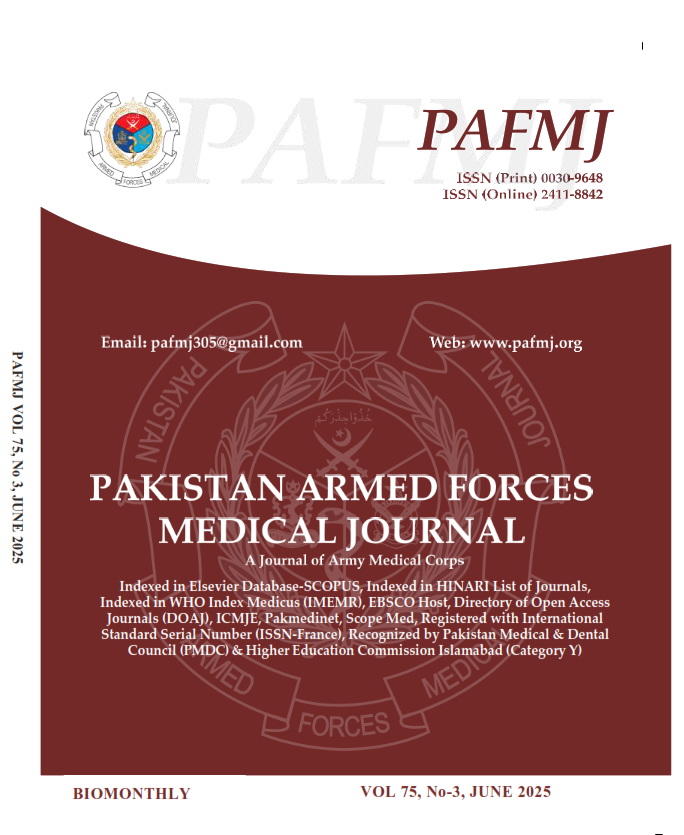Open Access Original Article The Best Imaging Modality for Axillary Lymph Node Status in Breast Cancer
DOI:
https://doi.org/10.51253/pafmj.v75i3.11374Keywords:
Cancer, Lymph node, Metastasis, MRI.Abstract
Objectives: To explore the diagnostic accuracy of different imaging modalities including Axillary Ultrasound (AUS), CT Scan and Contrast Enhanced Magnetic Resonance Imaging (MRI) breast in determining the axillary lymph node status in breast cancer keeping histopathology as reference standard.
Study Design: Retrospective Comparative Study.
Place and Duration of Study: The Breast Clinic, Combined Military Hospital, Rawalpindi Pakistan, from Jul 2022 to Jun 2023.
Methodology: A retrospective comparative study was conducted at a dedicated breast cancer center with 90 early breast cancer patients. Diagnostic accuracy of Axillary Ultrasound, contrast-enhanced CT, and MRI was evaluated for axillary nodal staging. Final histopathology served as the reference standard. Imaging interpretations were performed by experienced radiologists, and data were analyzed using SPSS 22.0. The following metrics were determined: accuracy, specificity, negative predictive value, sensitivity, and specificity.
Results: In total, 90 female patients mean age of 53.5±21.2 years were evaluated. N Staging displayed differences between patients who tested positive and negative for nodes. We found that MRI had the highest sensitivity of the three imaging modalities (93.34%: 95% CI, 84.34% - 98.82%) whereas CT scan had the lowest sensitivity (71.70%; 95% CI, 57.65% - 82.21). AUS had sensitivity (84.91%; 95% CI: 72.41% - 93.25) Similarly MRI had the highest Specificity of the three imaging modalities (78.38%: 95% CI, 61.79% - 90.17%) whereas CT scan had the lowest Specificity (62.96%; 95% CI, 42.37% -80.60%) and AUS had Specificity (67.57%; 95% CI: 50.21% - 1.99%).
Conclusion: MRI scan is more effective; Axillary Ultrasound shows better outcomes than..
Downloads
References
Wilkinson L, Gathani T. Understanding breast cancer as a global health concern. Brit J Radiol 2022; 95(1130): 20211033.
https://doi.org/10.1259/bjr.20211033
Azamjah N, Soltan-Zadeh Y, Zayeri F. Global trend of breast cancer mortality rate: a 25-year study. Asian Pac J Cancer Prev 2019; 20(7): 2015.
https://doi.org/10.31557/APJCP.2019.20.7.2015
Sung H, Ferlay J, Siegel RL, Laversanne M, Soerjomataram I, Jemal A, et al. Global cancer statistics 2020: GLOBOCAN estimates of incidence and mortality worldwide for 36 cancers in 185 countries. CA Cancer J Clin 2021; 71(3): 209-249.
https://doi.org/10.3322/caac.21660
Leemans M, Bauër P, Cuzuel V, Audureau E, Fromantin I. Volatile organic compounds analysis as a potential novel screening tool for breast cancer: a systematic review. Biomark Insights 2022; 17: 11772719221100709.
https://doi.org/10.1177/11772719221100709
Park YH, Lee SJ, Cho EY, Choi YL, Lee JE, Nam SJ, et al. Clinical relevance of TNM staging system according to breast cancer subtypes. Ann Oncol 2011; 22(7): 1554-1560.
https://doi.org/10.1093/annonc/mdq617
Peart O. Metastatic breast cancer. Radiol technol 2017; 88(5): 519M-539M.
Kay C, Martinez-Perez C, Dixon JM, Turnbull AK. The Role of Nodes and Nodal Assessment in Diagnosis, Treatment and Prediction in ER+, Node-Positive Breast Cancer. J Pers Med 2023; 13(10): 1476.
https://doi.org/10.3390/jpm13101476
Ellison LF, Saint-Jacques N. Five-year cancer survival by stage at diagnosis in Canada. Health Rep 2023; 34(1): 3-15.
https://doi.org/10.25318/82-003-x202300100001-eng
Lim YX, Lim ZL, Ho PJ, Li J. Breast cancer in Asia: incidence, mortality, early detection, mammography programs, and risk-based screening initiatives. Cancers 2022; 30; 14(17): 4218.
https://doi.org/10.3390/cancers14174218
Rahman M, Mohammed S. Breast cancer metastasis and the lymphatic system. OncoL lett 2015; 10(3): 1233-1239.
https://doi.org/10.3892/ol.2015.3486
Van Uden DJ, Prins MW, Siesling S, de Wilt JH, Blanken-Peeters CF, Aarntzen EH. [18F] FDG PET/CT in the staging of inflammatory breast cancer: A systematic review. Crit Rev Oncol Hematol 2020; 151: 102943.
https://doi.org/10.1016/j.critrevonc.2020.102943
Li P, Yang C, Zhang J, Chen Y, Zhang X, Liang M, et al. Survival After Sentinel Lymph Node Biopsy Compared with Axillary Lymph Node Dissection for Female Patients with T3-4c Breast Cancer. Oncologist 2023: oyad038.
https://doi.org/10.1093/oncolo/oyad038
Diessner J, Anders L, Herbert S, Kiesel M, Bley T, Schlaiss T, et al. Evaluation of different imaging modalities for axillary lymph node staging in breast cancer patients to provide a personalized and optimized therapy algorithm. J Cancer Res Clin Oncol 2023; 149(7): 3457-3467. https://doi.org/10.1007/s00432-022-04221-9
Menhas R, Umer S. Breast Cancer among Pakistani Women. Iran J Public Health 2015; 44(4): 586-587.
Morawitz J, Bruckmann NM, Jannusch K, Dietzel F, Milosevic A, Bittner AK, et al. Conventional Imaging, MRI and 18F-FDG PET/MRI for N and M Staging in Patients with Newly Diagnosed Breast Cancer. Cancers 2023; 15(14): 3646.
https://doi.org/10.3390/cancers15143646
Qiu SQ, Aarnink M, van Maaren MC, Dorrius MD, Bhattacharya A, Veltman J, et al. Validation and update of a lymph node metastasis prediction model for breast cancer. Eur J Surg Oncol 2018; 44(5): 700-707. https://doi.org/10.1016/j.ejso.2017.12.008
Ng WL, Omar N, Ab Mumin N, Hamid MT, Vijayananthan A, Rahmat K. Diagnostic accuracy of shear wave elastography as an adjunct tool in detecting axillary lymph nodes metastasis. Acad radiol 2022; 29: S69-S78.
https://doi.org/10.1016/j.acra.2021.03.018
Morawitz J, Bruckmann NM, Dietzel F, Ullrich T, Bittner AK, Hoffmann O, et al. Determining the axillary nodal status with 4 current imaging modalities, including 18F-FDG PET/MRI, in newly diagnosed breast cancer: a comparative study using histopathology as the reference standard. J Nucl Med 2021; 62(12): 1677-1683. https://doi.org/10.2967/jnumed.121.262009
James J, Teo M, Ramachandran V, Law M, Stoney D, Cheng M. Performance of CT scan of abdomen and pelvis in detecting asymptomatic synchronous metastasis in breast cancer. Int J Surg 2017; 46: 164-169.
https://doi.org/10.1016/j.ijsu.2017.09.004
Brenner DJ, Doll R, Goodhead DT, Hall EJ, Land CE, Little JB, et al. Cancer risks attributable to low doses of ionizing radiation: assessing what we really know. Proc Nat Acad Sci 2003; 100(24): 13761-13766. https://doi.org/10.1073/pnas.2235592100
Wimmer K, Fitzal F, Exner R, Gnant M. Axillary Management in the Neoadjuvant Setting. Breast Cancer Management for Surgeons: A European Multidisciplinary Textbook 2018: 291-301.
Mahmood T, Li J, Pei Y, Akhtar F, Imran A, Rehman KU. A brief survey on breast cancer diagnostic with deep learning schemes using multi-image modalities. IEEE Access 2020; 8: 165779-809.
Downloads
Published
Issue
Section
License
Copyright (c) 2025 Shandana Gul, Zaini Azam, Maria Mir Jan, Maham Tariq, Aqsa Saleema, Syeda Rifaat Qamar Naqvi

This work is licensed under a Creative Commons Attribution-NonCommercial 4.0 International License.















